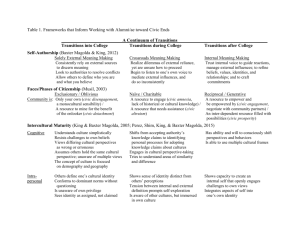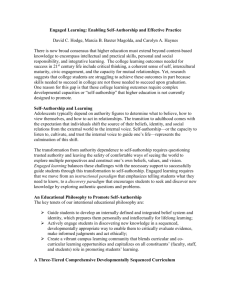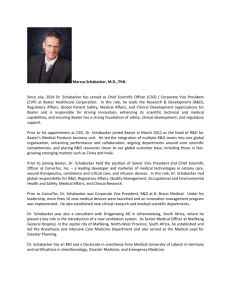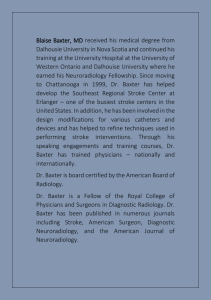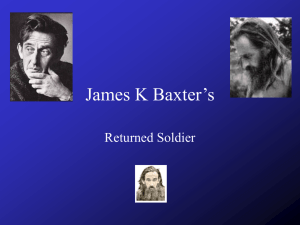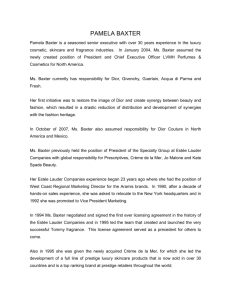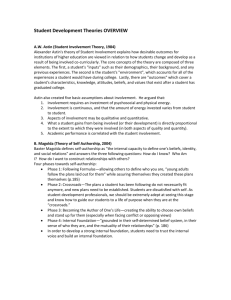Decreasing Authority Dependence During the First Year of
advertisement
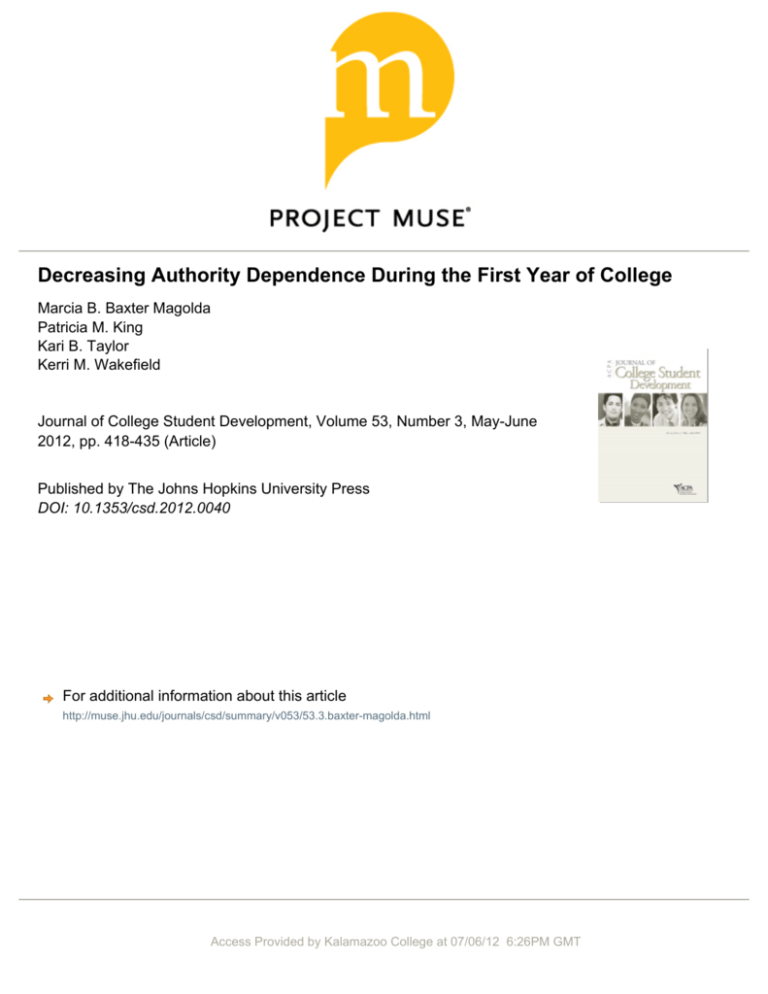
Decreasing Authority Dependence During the First Year of College Marcia B. Baxter Magolda Patricia M. King Kari B. Taylor Kerri M. Wakefield Journal of College Student Development, Volume 53, Number 3, May-June 2012, pp. 418-435 (Article) Published by The Johns Hopkins University Press DOI: 10.1353/csd.2012.0040 For additional information about this article http://muse.jhu.edu/journals/csd/summary/v053/53.3.baxter-magolda.html Access Provided by Kalamazoo College at 07/06/12 6:26PM GMT Decreasing Authority Dependence During the First Year of College Marcia B. Baxter Magolda Patricia M. King Kari B. Taylor Kerri M. Wakefield Annual interviews with 228 students at 6 diverse campuses in the Wabash National Study of Liberal Arts Education reveal 123 students’ developmental growth away from authority dependence between the beginning of the first and second years of college. In the first year of college, 86% of participants relied solely on external authorities to define their beliefs, identity, and relationships. At the start of their second year, 57% relied solely on external authorities. We used students’ narratives about the effect of their academic, cocurricular, and personal learning experiences to map the nature of their journeys out of authority dependence and toward self-authorship. Colleges and universities have made significant strides in recent years to enhance students’ experiences during their first year in college (Barefoot et al., 2005). These efforts focus on helping students meet the academic and social expectations of college, learn the skills to succeed in advanced study, and build a bond with their college community. Less attention has been devoted to how to help first-year college students build the developmental capacities they need to meet desired learning outcomes of college (Skipper, 2005). Research shows that entering college students often adopt what to believe, how to view themselves, and how to act in relationships from external authorities without carefully examining their own thoughts and feelings (e.g., Abes & Jones, 2004; Baxter Magolda, 2001; Bekken & Marie, 2007; King, Baxter Magolda, Barber, Kendall Brown, & Lindsay, 2009; King & Kitchener, 1994; Torres & Hernandez, 2007) and thus are “in over their heads” (to use Kegan’s, 1994, phrase) when it comes to achieving desired learning outcomes, such as critical thinking and intercultural maturity. Relying on external authorities for knowledge yields memorization and uncritical acceptance of others’ perspectives (Baxter Magolda, 1992; Belenky, Clinchy, Goldberger, & Tarule, 1986; King & Kitchener, 1994; Perry, 1970). It complicates making academic and career decisions and behavioral choices because external authorities sometimes disagree, leaving the person unsure how to make good choices (Creamer & Laughlin, 2005; Pizzolato & Ozaki, 2007). Reliance on external authorities complicates the process of relationships because it is impossible to please everyone (e.g., one’s parents and one’s peers; Boes, 2006; Kegan, 1994). Reliance on external authorities can also lead to acceptance of negative racial and ethnic stereotypes (Pizzolato, Chaudhari, Murrell, Podobnik, & Schaeffer, 2008; Torres, 2009; Torres & Baxter Magolda, 2004). Thus Marcia B. Baxter Magolda is Distinguished Professor of Educational Leadership at Miami University. Patricia M. King is Professor in the Center for the Study of Higher and Postsecondary Education at the University of Michigan. Kari B. Taylor is Associate Director for Student Development in the Honors Program at Miami University. Kerri M. Wakefield is a doctoral candidate in the Center for the Study of Higher and Postsecondary Education at the University of Michigan. The authors gratefully acknowledge the Center of Inquiry in the Liberal Arts at Wabash College for its support of this project. 418 Journal of College Student Development Decreasing Authority Dependence students’ lack of necessary developmental capacities complicates everyday life on campus, and compromises achievement of higher order learning goals (Pizzolato, Hicklen, Levine Brown, & Chaudhari, 2009). The learning outcomes many educators emphasize require self-authorship, that is, the internal capacity to author one’s views, identity, and relationships (Baxter Magolda, 2001, 2004; Kegan, 1994; King & Baxter Magolda, 2005). For example, many educators embrace critical thinking as a learning goal. They attempt to teach students to expand their perspectives and learn to judge what to believe rather than repeating faculty views in order to get good grades. They encounter difficulty when students’ lack of internal capacity prompts them to write what they think instructors want. Thinking critically and learning from mistakes requires more complex ways of making meaning of knowledge and acknowledging one’s role in constructing it (Baxter Magolda, 2001; King & Kitchener, 1994; Perry, 1970). A similar issue arises when educators work with students to help them avoid inappropriate behavior that stems from racist or ethnic stereotypes. Student affairs educators devote extensive energy to helping students appreciate difference, understand privilege and oppression, and learn how to interact effectively across difference. Yet racism and homophobia continue to be a concern on most college campuses. One contributing factor is the lack of attention to fostering the developmental capacities needed to appreciate difference. To appreciate difference, students must have the capacity to internally generate their values, construct an identity that is strong enough to avoid perceiving others’ differences as a threat, and view relationships as mutual rather than acting to please others (Kegan, 1994; King & Baxter Magolda, 2005). Complex developmental capacities also help marginalized and privileged persons deal with racism and reject negative stereotypes (Torres, 2009). Thus, much of what educators ask of college students requires that they move away from authority dependence toward self-authorship. Success in promoting developmental capa­ cities is possible when educational practice is devel­op­mentally sequenced to foster increasingly adaptive ways of making meaning of one’s beliefs, identity, and relationships (e.g., Bekken & Marie, 2007; Taylor & Haynes, 2008) so that students grow away from authority dependence and move toward self-authorship. This article reports the developmental growth of 123 students during their first year of college to offer insight into how educators can shape the first college year to help students build crucial developmental capacities. The data are drawn from the Wabash National Study of Liberal Arts Education (http://www.liberalarts.wabash. edu/nationalstudy; hereafter, WNS), a study designed to discover the student experiences and underlying developmental capacities that affect growth toward seven liberal arts outcomes—(a) integration of learning, (b) inclination to inquire and lifelong learning, (c) effective reasoning and problem solving, (d) moral character, (e) intercultural effectiveness, (f ) leadership, and (g) well-being—that lead to wise citizenship (King, Kendall Brown, Lindsay, & VanHecke, 2007). The students’ narratives reveal the kinds of experiences that motivate students to move away from authority dependence and toward the kinds of meaning-making approaches associated with the achievement of liberal arts outcomes. Theoretical Foundation for the Wabash National Study The interview portion of the WNS is grounded in the theory of self-authorship (Baxter Magolda, 2001; Kegan, 1994) and Piaget’s (1950) constructive-developmental tradition. May/June 2012 ◆ vol 53 no 3419 Baxter Magolda, King, Taylor, & Wakefield Constructivism means that people interpret their experiences to actively construct their perspectives, and developmentalism suggests that these constructions form meaning-making structures that evolve over time (Kegan, 1982). Following Perry’s (1970) seminal work describing college students’ meaning-making structures, numerous theorists in this tradition expanded our understanding of students’ epistemological development (e.g., Baxter Magolda, 1992; Belenky et al., 1986; King & Kitchener, 1994). Kegan (1994) described this kind of development as “the evolution of consciousness, the personal unfolding of ways of organizing experience that are not simply replaced as we grow but subsumed into more complex systems of mind” (p. 9). He identified one of the more complex systems of mind as self-authorship, or the capacity to internally generate belief systems, intrapersonal states, and interpersonal loyalties. Kegan also portrayed development as the integration of epistemological (assumptions about knowledge), intrapersonal (assumptions about self or identity), and interpersonal (assumptions about relationships) dimensions. Additional research refined the concept of self-authorship through studies of various college student populations. Participants in Baxter Magolda’s 25-year longitudinal study (2001, 2008, 2009) relied on external formulas throughout college, developing self-authorship during their late twenties and thirties. In contrast, participants in Abes’s (2003; Abes & Jones, 2004) and Torres’s (2003; Torres & Hernandez, 2007) longitudinal studies developed self-authorship capacities during college. Pizzolato (2003, 2004) also reported self-authorship capacities in students entering college. In most cases, participants who developed self-authorship capacities prior to or during college experienced marginalization and were often required to discard external formulas because they did not lead to 420 success. Collectively, this line of research demonstrates that development evolves from relying primarily on external sources for meaning making, through relying on a mix of external and internal sources (what Baxter Magolda called the crossroads), to relying primarily on internally generated meaning making (see Taylor, 2008, for an integration of developmental theories). Method Methodological Foundation Consistent with the constructive-develop­ mental tradition, we employed constructivist assumptions (Lincoln & Guba, 2000) to guide our methods; these included assuming that selfauthorship development is socially constructed and context-bound, that it takes multiple forms, and that our ability to understand interviewees’ development is shaped by the interaction of the interviewer and interviewee. Thus the WNS Interview was designed “to elicit students’ characteristics, the nature of the educational experiences they viewed as significant, and how they made sense of those experiences” (Baxter Magolda & King, 2007 p. 500). This approach enabled interviewers to learn about the particular background characteristics, histories, and initial meaning-making assumptions students brought to the college experience. We assumed that these characteristics would influence the experiences students pursued in college and how they participated in required experiences. For example, students with little experience with diverse others might hesitate to engage in a cultural immersion experience or come away from such an experience more prone to avoid difference. Students with more experience with diverse others might seek out such experiences and be more comfortable exploring new perspectives they encounter. Exploring the experiences students identified as significant enabled interviewers to learn Journal of College Student Development Decreasing Authority Dependence how students approached their experiences and why they saw them as important. Pursuing why they interpreted their experiences in particular ways revealed their assumptions about knowledge, identity, and relationships. These meaning-making structures shaped their initial interpretations (e.g., what they learned from the experiences) and their interpretations in turn sometimes prompted evolution of these meaning-making structures. By examining students’ interpretations of their college learning experiences over time, we can determine how students interpret their experiences to retain or alter their original assumptions in developmentally adaptive ways. A dual purpose of the interview was to trace students’ growth toward seven liberal arts outcomes; this article focuses on the developmental capacities underlying those outcomes. This theoretical framework and contem­ porary self-authorship research guided con­ struc­tion of the first data analysis protocol we used in the pilot study for the WNS (King, Baxter Magolda, Barber, Kendall Brown, & Lindsey, 2009). We constructed theoretical descriptions of meaning making at three developmental levels: meaning making based on external sources (e.g., societal expectations); meaning making that used a mix of external and internal sources; and meaning making based on internal sources (e.g., one’s personally defined beliefs). We began with this broad continuum rather than specifically using any of the existing theoretical models because existing research is not clear about the degree to which self-authorship reflects assumptions that are culturally specific. Because the WNS includes a diverse group of students, we used this approach to allow the particulars to emerge from the data. We initially used this broad continuum to interpret 174 interviews from the pilot phase of the WNS. We used the themes in the pilot data to refine our descriptions of the three broad levels and used this second, refined protocol to interpret the 315 interviews in the first year of the longitudinal WNS. As we obtained more extensive data, particularly in the external and mixed levels, we identified variations within external and mixed meaning making. We incorporated these variations, as well as those Baxter Magolda (2008) identified in the internal level, into a third, more detailed longitudinal data analysis protocol (Baxter Magolda & King, 2008a). In this third protocol, we captured the gradual movement of external forces to the background and internal authority to the foreground by creating a rating scheme that uses “E” to symbolize external meaning making and “I” to symbolize internal meaning making, and plotting this onto the continuum depicted in Figure 1. The current analysis protocol is an advancement over our earlier protocol in that it includes: three variations of external meaning making, Ea, Eb, Ec; two variations of predominantly external meaning making, E(I), E-I; two variations of predominantly internal meaning making, I-E, I(E); and three variations of internal meaning making (i.e., self-authorship), Ia, Ib, Ic. We refer to these variations as positions. The ten developmental positions that we derived from the data paralleled prior research describing the journey toward self-authorship. Thus for continuity, we adopt the language of crossroads as an umbrella for the two predominantly external and two predominantly internal positions, and self-authorship to capture the three internal positions. Figure 1 shows the key characteristics of all ten positions and depicts the broad contours of the development of complex meaning making. However, the figure does not capture the multiple pathways individuals take along this journey, such as shifts in meaning making across contexts, or meaning making that spans different positions. The major advantage of this protocol is that May/June 2012 ◆ vol 53 no 3421 Baxter Magolda, King, Taylor, & Wakefield FIGURE 1. Journey Toward Self-Authorship it enables the use of finer distinctions within broader developmental levels than has been available in prior research. Sampling The WNS used a longitudinal concurrent mixed methods design (Tashakkori & Teddlie, 422 2003); that is, researchers asked similar research questions in both the quantitative and qualitative portions of the study, conducted data collection and analysis for each portion independently, and conducted assessments for both portions over time. Researchers used a two-step sampling strategy to select Journal of College Student Development Decreasing Authority Dependence participating institutions. In the first step, 19 institutions were selected from more than 60 colleges and universities responding to a national invitation to participate in the WNS based on their applications that described their vision of liberal arts education and the practices they implemented in the service of this educational goal. They were also selected to reflect a variety of institutional characteristics, including institutional type and control, size, and location, among others. These institutions comprise the survey portion of the study; students were randomly selected from among first-time, first-year, traditional-age students attending these institutions. In the second step, 6 colleges and universities were selected from the survey campuses to also participate in the interview portion of the study. They were selected to yield a group of institutions that reflected different institutional types, a geographically diverse institutional sample, and student bodies that were sufficiently diverse to increase the likelihood of obtaining an adequate sample of students of color. The resulting interview campuses consist of 4 small colleges, 1 mid-sized, and 1 large university; 2 are Hispanic-serving institutions and 1 has an enrollment that is approximately half African American students. Interview participants were selected from the students at 6 institutions who completed the quantitative survey component of the study who also indicated their willingness to be contacted to participate in an interview. Men and students of color were over-sampled to obtain a more balanced distribution by gender and race/ethnicity. These steps yielded a sample of 315 students who were interviewed in the fall of 2006 (hereafter, Year 1). We were able to contact and re-interview 228 of these students in the fall of 2007 (Year 2). The Year 2 sample included 145 males (46%), 23 students who identified as African American, 22 as Hispanic, 16 as Asian / Pacific Islander, and 6 as mixed racial heritage. Additionally, 5 were born in countries other than the U.S. After reviewing the distribution of selfauthorship ratings (discussed below), we chose to focus on the 123 individuals who exhibited growth within and across external and predominantly external meaning making. Since this type of growth is the phenomenon of interest in the current article, those with positive growth ratings in these structures constitute the sample for the current analysis. Experi­ences of students whose ratings remained the same or showed developmental reversals will be the subject of future reports. Interview Protocol We organized the interview into three seg­ ments to give respondents maximum freedom to identify relevant content, yet enable inter­ viewers to elicit information about the con­di­ tions that foster growth on the seven outcomes and self-authorship (Baxter Magolda & King, 2007). The main segments of this informal conversational interview are constructed in situ—as the conversation unfolds (Patton, 2001). The opening segment focused on how students’ entering characteristics (i.e., ways of constructing knowledge, self, and relation­ ships; personal history) affect development toward self-authorship. The second, and primary, portion of the interview elicited the educational experiences that students regard as key to their development and why these particular experiences are relevant. Interviewers then engaged students in conversation, asking students: to describe their experiences; to explain how they made sense of the experiences; and to discuss how the experiences affected the way they decide what to believe, how to view themselves, and how to construct relations with others. The third segment elicited the respondents’ synthesis of their experiences and how their collective experiences shaped how they view the world and themselves. Interviews May/June 2012 ◆ vol 53 no 3423 Baxter Magolda, King, Taylor, & Wakefield lasted 60 to 90 minutes and were transcribed verbatim. Interview Analysis Working from the complete interview tran­ scripts, trained team members created sum­ maries of each interview that consisted of three major elements: (a) an overview of the student’s background characteristics; (b) a description of each experience the student identified as important, its effect on the student, the relationship of the effect to liberal arts outcomes, whether it contributed to the student’s development and if so, how, and illustrative quotes from the student; and (c) an assessment of the student’s developmental meaning making in cognitive, intrapersonal, and interpersonal dimensions, as well as an overall assessment across dimensions illustrated with verbatim excerpts (Baxter Magolda & King, 2008a). We used the longitudinal data analysis protocol described earlier to reanalyze the Year 1 interviews in order to sustain a consistent protocol over the longitudinal analysis; we then used it to analyze the Year 2 interviews. Because the focus of this article is on change over time, we conducted a procedural check on rating by reviewing summaries that reflected an unusual amount of increased or decreased complexity; this allowed us to verify that high increases in ratings reflected a dramatic shift in the student’s meaning making rather than inconsistent rating. Trustworthiness We addressed issues of trustworthiness in several ways. Extensive training for all interviewers and summarizers included training in the constructivist developmental foundation that guided the interview construction and analysis, training in the purpose of the interview, practice interviewing with feedback, an analysis of interviewer subjectivities, and practice summary writing with feedback. We enhanced credibility 424 through prolonged engagement with the participants: the individual interviews typically lasted over an hour and occurred annually. Transcripts of interviews were made avail­ able to participants, who were invited to fill in words that were inaudible, correct factual errors, and offer comments or additional insights. We have not conducted member checks due to the size of the interview sample and because our face-to-face contact was limited to the annual interview weeks on each campus. Additionally, we conducted daily debriefing sessions among interviewers during data collection to triangulate their experiences and early interpretations about the campus context and content of the interviews. Similarly, multiple team members were involved in data analysis, discussing alternative perspectives and interpretations. We triangulated interview data with the quantitative measures of students’ educational experiences (Seifert, Goodman, King & Baxter Magolda, 2009). We enhanced transferability through the use of thick description of the narratives whenever possible. Findings Distribution of Self-Authorship Ratings for All Longitudinal Participants Figure 2 shows the distribution of selfauthorship ratings for the longitudinal inter­ view sample (N = 228) for Years 1 and 2. As indicated there, the ratings of the majority of participants were in the external positions (Ea, Eb, and Ec); thus, the source of their meaning making was an external voice (i.e., outside of themselves), such as parents, professors, and others whom they perceived as knowledgeable. In Year 1, 86% of the students were externally defined; their approach reflects what Baxter Magolda (2001) referred to as “following formulas” (p. 40). A much smaller portion (9%) received ratings in the predominantly Journal of College Student Development Decreasing Authority Dependence external positions of E(I) or E-I, and only 4% were rated as predominantly internal, I-E or I(E). None evidenced internal meaning making. By Year 2, these percentages were (respectively) 57%, 34%, and 9%. This pattern of change shows a dramatic drop in the number of students who relied on external definitions of knowledge, self, and relationship, and an increase in the number of students who were starting to use internal standards of evaluation, although most still used meaning-making positions that were predominantly external. The majority (n = 144; 63%) showed development (Year 2 ratings reflected more complex meaning making than Year 1 ratings); 41 (18%) showed no change; and the ratings of 43 students (19%) showed decreased complexity. Of the 144 students who showed development, 123 exhibited more complex meaning making either within external meaning making or from external to predominantly external meaning making, illustrating decreas­ ing authority dependence. Table 1 shows the distribution of the change ratings (i.e., Year 1 to Year 2 positions) for these 123 students, who are the focus of the present article. Movement within External Meaning-Making Positions Among the 63% of the sample whose ratings increased, the movement of 53 students (37%) was still within the external range (from Ea to Eb, Ea to Ec, or Eb to Ec). Overall, these students relied on others to decide what to believe, how to define themselves, and how to be in relationship with others; however, the degree to which they relied on others and the extent to which they comfortably did so varied depending on their particular developmental position. The key distinction between Ea and Eb is that as individuals move toward FIGURE 2. Distribution of Self Authorship Ratings, Year 1 and Year 2 (N = 228) May/June 2012 ◆ vol 53 no 3425 Baxter Magolda, King, Taylor, & Wakefield Table 1. Movement Within External and From External to Predominantly External Positions, Year 1 to Year 2 (N = 123) Developmental Movement Number of Students Within External Ea to Eb 21 Ea to Ec 20 Eb to Ec 12 From External to Predominantly External Ea to E(I) 14 Ea to E-I 6 Eb to E(I) 24 Eb to E-I 10 Ec to E(I) 8 Ec to E-I 8 the Eb position, they begin to experience some tension in relying on external sources to define their identities, relationships, and beliefs; such tension arises particularly when external sources (e.g., parents, educators, mass media) conflict with one another and serves as the impetus for individuals to begin questioning which external sources to follow and when to follow them. As individuals move toward the Ec position, they become better able to recognize the shortcomings of relying on external sources and to articulate the need to develop an internal source to define their identities, relationships, and beliefs. Thus, at Ea, students rely on external sources consistently and unquestionably; at Eb, students still rely on external sources but begin to have questions or concerns about doing so; at Ec, students have not yet moved away from relying on external sources but see the need to lessen their dependence on external sources. Below, we use verbatim quotes from interview transcripts from students whose growth 426 patterns from Year 1 to Year 2 indicated that they were becoming less dependent on external sources; we also provide our interpretation of each student’s growth pattern. Logan: Learning to Acknowledge Uncertainty. Logan is an engineering student at a mid-sized private university in the Midwest. During the Year 2 interview, Logan discussed taking his first philosophy class, which he described as a major change from his engineering classes. He explained: It’s a real big change going from a class where there’s a right answer and a wrong answer to a class where there’s a million answers, none of which are right and none of which are wrong. It is kind of annoying. I sit down to write a philosophy paper and I’m looking at the prompt and it’s: “Present an argument for or against this.” And I’m like, well, how can it be an argument for it and against it? That just doesn’t seem right at all. And that’s actually been really frustrating for me, at least at the start of the year, trying to write papers, and just think of what my point of view is on something and defend it as opposed to putting my answer down and saying either it’s right or it’s wrong. We interpreted Logan’s meaning making in Year 2 to be Ec because he recognized that questions—at least in some fields—have many possible answers and that he needs to decide what he believes. He was frustrated by the need to articulate his point of view because he was beginning to understand that he cannot rely on others to provide him with the “right” point of view but had not yet begun to develop an internal voice for figuring out truth for himself. Logan’s ability to see that “there’s a million answers, none of which are right and none of which are wrong” in his philosophy class represents growth from his first year in which he stated that he focused on gaining knowledge from his teachers. He noted in his Year 1 interview, “If I see it and I hear it from the Journal of College Student Development Decreasing Authority Dependence teacher, usually I can sort of work back in my head and figure out answers on tests.” During Year 1, his frustration stemmed not from the challenge of developing his point of view but rather from the need to read textbooks to learn material that teachers did not cover in their lectures. We interpreted Logan’s meaning making in Year 1 to be Ea because of his desire to rely on external sources such as teachers and textbooks to find answers; this differs from his meaning-making position in Year 2 because he did not yet recognize that external sources may not have the right answer or may have only one of many answers. Ultimately, from Year 1 to Year 2, Logan grew slightly less dependent on external sources for discovering knowledge. Tommy: Learning to Respect Multiple Perspectives. Tommy, a male student at a small private college in the Midwest, is actively involved in student organizations including several Christian groups. In his Year 2 interview, he explained that he had discovered that he has more in common with people who are different from him than he had originally predicted. Explaining how he managed friendships with peers whose religious views differ from his own, he stated: I remember just eating with one of my friends who was an atheist. He kind of talked about his problem and it’s really hard, because I have learned how to share my faith with people and I feel like it’s always going to work. Why wouldn’t somebody want to try this out? . . . So, I want to get their point of views just like I want them to get my point of views—just because, first of all, it’s the good thing to do. I want to be a friend with them. . . . It’s not like I want to cut off from them just because they are different from me. . . . You meet a lot of new people here and you just got to let them get what they want to say out, too, because as soon as you start thinking you’re right, you’re right, you’re right, and you think “Well, this person doesn’t need to talk, because what I am saying is right,” and you are not respecting their time, and they are not going to respect yours. Tommy sought to be understood and also wanted to understand and respect his peers, even when his peers had different religious views than his own. His ability to recognize that multiple perspectives regarding religion exist is similar to Logan’s ability to recognize that multiple answers regarding philosophical issues exist. Also, while Logan began to recognize the need to decide what he believes, Tommy began to recognize the need to define for himself what constitutes good peer relationships. In particular, Tommy became aware that he could foster friendships with people who have backgrounds that are different from his own. Thus, we interpreted Tommy’s meaning making at Year 2 to be Ec, too. Tommy’s willingness to engage with and learn from people in different circles represents growth from his first year in which he seemed to build friendships primarily with individuals who shared his interests and values. For example, in his Year 1 interview, he explained, “Having friends [in high school] that didn’t drink is so much easier because you don’t have to go to a party and get pressured nonstop to drink.” We interpreted Tommy’s meaning making during his first year to be Ea, given that he did not provide us evidence that he questioned the source of either his or others’ perspectives. His lack of desire to reach out and relate to others who were different from him in some way contrasts with his interactions with others during his second year in which he seemed comfortable interacting with diverse others and could see the shortcomings in thinking that his perspective was the only right one. Ultimately, from Year 1 to Year 2, Tommy grew slightly less dependent on external sources such as his peers for defining his identity and belief system. May/June 2012 ◆ vol 53 no 3427 Baxter Magolda, King, Taylor, & Wakefield Sarah: Learning to Acknowledge One’s Own Needs in Relationships. Sarah, an art history and business double major at a small private college in the West, described several significant relationships including those with her boyfriend, friends, and roommate during both her Year 1 and Year 2 interviews. Explaining how her view of friendships evolved from her first year to her second year in college, she said: I guess being myself, not really trying to be good for everyone is really important to me. . . . just admitting what I like rather than being around someone and they’re saying like, “I don’t like this show,” and you’re like, “Me, neither.” [Instead] be like, “Well, I’m going to watch it and see what I feel,” and if we differ on it or what. Like it’s just learning to put those kind of differences aside even, to be a friend with someone or to be okay with someone, not necessarily adapting to exactly what they like, but just learning how to accept it and, and having them accept me for who I am or what I like or what I feel and that kind of thing, so that’s kind of being myself. (laughs) Sarah was learning through different relationships that she needed to take her own needs into account. Her realization that she needs to be herself, even if that involves being different from others, led us to interpret her Year 2 meaning making to be Ec. In essence, in her Year 2 interview, she articulated the shortcomings of altering her needs and interests based on what others expected of her. She, like Tommy, was becoming more comfortable with interacting with those who are different than she is. Her desire to be herself in relationships, which she expressed during her second-year interview, contrasted with her desire to share similarities with her roommate during her first year. Describing her relationship with her first-year roommate, she said, “We go to bed at the same time, we go everywhere together, we always get hungry at the same time, or it 428 just worked out that way. She’s a whole lot louder than me, but I’m patient so it doesn’t get annoying.” When differences arose, such as volume of noise in the room, Sarah suppressed them and seemed to defer to her roommate’s needs and interests. We interpreted Sarah’s meaning making during Year 1 to be Ea because she consistently and unquestioningly aligned her actions and beliefs with those of her peers. From Year 1 to Year 2, she grew better able to stand apart from her peers in order to be herself. Ultimately, she became slightly less dependent on her peers’ approval. Students who exhibited movement from Ea or Eb to Ec reported becoming increasingly aware of uncertainty and recognizing multiple perspectives. They found this frustrating and were unsure how to proceed. In the next section, we show how students’ internal voices began to emerge for those who moved from the firmly external to the primarily external level of development. Movement from External to Primarily External Meaning-Making Positions Among the 144 in the sample (63%) whose ratings increased toward the internal end of the developmental spectrum, the movement of 70 students (49% of those whose ratings increased) was from external to primarily external; in other words, these students moved from Ea, Eb, or Ec to E(I) or E-I. Overall, these students still relied on external sources but also were beginning to bring their emerging internal voices to the forefront to decide what to believe, how to define themselves, and how to be in relationship with others. A key distinction between the Ec and E(I) positions is that as individuals move toward E(I), they demonstrate an awareness of how they themselves construct their identity, relationships, and belief system in comparison to how external sources do so. In essence, they begin to develop an internal voice for their identity, relationships, and Journal of College Student Development Decreasing Authority Dependence belief system. Then, as individuals move from E(I) to E-I, the internal voice grows more well-defined and thus becomes a more visible, active force in their decision-making process. Individuals at this position want to rely on their newly emerging internal voices but find it difficult to do so amid the still present external sources. Ultimately, the degree to which an internal voice was evident in the participants’ interviews determined our interpretation of their specific developmental position. If an internal voice was evident but not yet in competition with external sources, we interpreted their developmental position to be E(I). If an internal voice was present enough to compete with external sources for dominance, we interpreted their developmental position to be E-I. Will: Learning to See Peers as Teachers. Will, a theater major at a small private school in the Midwest, enjoyed discussion-based classes that allowed him to learn from fellow students. During his second year of college, Will began to expect to learn as much from his peers as he did from professors. He explained: Everybody is learning from everybody else just as much as everybody’s teaching everybody else, giving your own percep­ tions and giving your own thoughts while taking in everyone else’s. So it really makes it a very even playing field. . . . I like to sit back and take in other people’s ideas and personally tally them up compared to mine and eventually make my remark or my particular statement. . . . It comes back to new and different perspectives, and you gain an appreciation for other people. I mean when something like this happens, even the youngest freshman can see something that the high and wise senior doesn’t. . . . And I think you also gain an appreciation for each person as an individual. We interpreted Will’s openness to inter­ acting with diverse others to be slightly more advanced than the openness that Tommy and Sarah demonstrated, because he not only listened to others’ perspectives but also sought to develop a reciprocal relationship with them in which he was simultaneously a teacher and a learner. Moreover, we interpreted his meaning making to be E-I because he was beginning to gain confidence and experience in using his internal voice, though external forces still influenced when and how he chose to speak up during class discussions. His ability and willingness to actively contribute to the learning process during his second year of college contrasts with the role he played in classes during his first year of college. During his Year 1 interview, Will expected professors to provide a clear process by which to understand concepts and figure out solutions; he, in turn, attentively observed and mimicked the process a professor used. Discussing his experience in an astronomy class, Will explained: [The professor] will go, “Okay, here I said this, now you’re going to prove it,” and he’ll hand out papers that will give us the math and then we actually, literally have to learn. . . . You learn how to do things. You learn how to understand and how to think about them. Will had begun to explore and question how others such as astronomers construct knowledge, but he played the role of an interested observer rather than an active contributor to the knowledge-construction process. Because he still relied pretty consis­ tently on external sources for gaining knowl­ edge, we interpreted his meaning making during his first year to be Eb. From Year 1 to Year 2, Will began to develop an internal source for evaluating knowledge and contributing to the learning process. Chase: Learning to Stand Up for Himself. Chase, a male student, started college at a small private institution in the West after taking a May/June 2012 ◆ vol 53 no 3429 Baxter Magolda, King, Taylor, & Wakefield year off following high school to pursue music and film. During his Year 2 interview, Chase stated that he was learning to stand up for himself and to control his feelings even when faced with external pressure to feel otherwise. He recounted a complicated situation in which he was trying to be open minded and found himself in a situation he did not anticipate. He accepted an invitation to another man’s room but misunderstood the unwritten rules that this meant having sexual relations. Chase rejected the man’s advances and maintained confidence in this decision, which he described as a turning point because his usual tendency was to feel guilty for not doing what someone else wanted. He explained how he handled the situation: I called him and I’m like, “Hey, you want to talk?” So he was like “Sure.” So we walked around and I told him, “Yeah, I’m not looking for anything this year, or at that present moment. I just wanted to be friends.” And he was mad because he wanted to pursue something else with me, something more intimate in which I was like, “No, not right now,” because I just met him. So he tried to make me feel guilty. . . . I was able to stand up for myself, because normally I would have been, “Bye, I’m never going to talk to you again.” Instead, I was able to make contact with him and tell him this is where I’m coming from. . . . I could feel his intention was to make me feel guilty so that I would be like, “Okay, I’m going to pursue an intimate relationship with you because of all the things you just said to make me feel guilty.” . . . Rather than feeling this way, I was able to see what he was doing, and I’m like, “No, I know exactly what he’s doing here and I choose not to feel this way.” So I was like, “Wow, I’m so amazing. I’m able to not feel guilty.” Chase’s newly emerging ability to manage his feelings despite the pressure from his peer led us to interpret his meaning making at Year 2 to be E(I). He was able to distinguish 430 how he wanted to feel about the situation from his peer’s desire to make him feel guilty, which is evidence that Chase’s internal voice was developed enough to overcome external sources on at least some occasions. Because he indicated that this was one of the first times and settings in which he was able to overcome external influence, we saw this situation as evidence of his first step toward internal meaning making; yet, using his internal voice had not become a common or comfortable practice for him. Throughout his first year, Chase tried not only to dismiss his feelings, but he also tried to alleviate pressure he felt from external sources. In his Year 1 interview, he noted, “I knew that I was going to face homophobia, um, and a part of me wanted to just come out with it, so that there’ll be less pressure on me. I would be less nervous because I knew everyone knew and I wouldn’t have to prove anything.” In contrast to the ability to control his feelings and stand up against peer pressure that he started to gain during his second year, Chase allowed external sources to influence his feelings and decisions during his first year. We interpreted Chase’s meaning making during his first year to be Eb because he experienced some tension amid the influence of external sources but had not yet shown signs of developing an internal voice for defining his identity, relationships, and beliefs. By Year 2, though, Chase’s internal voice had emerged and, in some cases, begun to compete for dominance with external sources. Ultimately, from Year 1 to Year 2, he grew increasingly able to internally define who he is and how he relates to others. For students such as Will and Chase who moved from the firmly external to primarily external level of development, the emergence of their internal voices was salient in the way they described their experiences. They realized the value of an internal voice in learning from each other, creating more Journal of College Student Development Decreasing Authority Dependence effective relationships, and figuring out how to be successful on their own terms rather than being consumed by others’ perceptions. Despite this recognition, their internal voices were still in the background and not yet strong enough to consistently and effectively mediate the external sources they encountered. Discussion Developmental changes from Year 1 to Year 2 demonstrate a gradual decrease in authority dependence over the first college year. In Year 1, only 14% of the participants exhibited any form of internal voice, that is, E(I) or above, and 9% of those were still using predominantly external meaning-making structures. In Year 2, 43% exhibited some form of internal voice, with 34% of those using predominantly external meaning-making structures. Thus, a third of the group showed evidence of using some internal voice compared to less than a tenth of the group at the outset of college. Although 57% in Year 2 were still using external structures, many had moved forward a position or two. Encounters with multiple perspectives, whether through academic work or peer interactions, prompted students who entered college heavily reliant on external sources to wrestle with uncertainty and contradictions between sources. Students also experienced dissonance when educators expected them to take more responsibility for their learning and when peer relationships did not meet their needs; such experiences yielded the insight for some that they needed to participate more fully in their learning and express themselves in relationships. Some were able to act on this insight in some aspects of their lives, yet external sources still overshadowed these students’ emerging internal voices. The student narratives reveal the challenges students encountered but contain little detailed commentary on support they received in developing their internal voices. For example, Logan’s professors conveyed the importance of finding information beyond the lecture and of multiple perspectives, but Logan did not report how professors guided him in learning how to address these new expectations. Similarly, Tommy discovered that he and his peers had multiple perspectives, yet he was unsure how to go about sorting them out. Sarah learned that she was allowing others to control her relationships, but she was uncertain about how to resolve this issue. In each case, students experienced a challenge to their current way of making meaning, but stopped short of describing support for creating a new way of making meaning. While students were gradually adjusting to the academic and social expectations of college life and moving toward more complex meaning-making structures, 57% of them still relied on external sources to define their beliefs, identities, and relationships in their second year. In essence, many of them continued to lack the developmental capacities needed to fully meet the challenges and expectations they were experiencing in college. Implications for Student Affairs Students who still use external positions could benefit from Taylor and Haynes’s (2008) developmentally sequenced framework for curricular and cocurricular experiences. This framework is based on the Learning Partnerships Model (Baxter Magolda, 2004) and thus emphasizes establishing both learning and developmental goals that offer the optimal balance of challenge and support for students’ current meaning-making structures. This balance is achieved by providing sufficient scaffolding for learners to begin constructing new ways of making meaning. This three-tier model attempts to connect to students’ current meaning making, yet acknowledges the fluidity of meaning-making structures through a May/June 2012 ◆ vol 53 no 3431 Baxter Magolda, King, Taylor, & Wakefield mutual learning partnership. Because learners and educators are mutually constructing practice, the focus remains on mutually identifying and working on learning and developmental goals rather than simply identifying current meaning making. Taylor and Haynes (2008) described the first tier of their three-tier model as best suited to help students who follow external formulas— Ea, Eb, Ec—move toward the crossroads— E(I), E-I, I-E, I(E). Taylor and Haynes’s first tier aims to help learners address challenges such as recognizing mul­tiple perspectives and identifying the limita­tions of relying on others’ approval, which our participants experienced during their first year of college. Miami University Office of Residence Life (2010) adopted this model, along with Kerr and Tweedy’s (2006) residential curriculum concept, to construct a residential curriculum to promote academic success, intrapersonal development, cultural proficiency, and com­ mu­nity engagement among residents. Scaffold­ ing to help learners respond to multiple perspectives included staff guided discussions to craft community agreements and servicelearning opportunities (Miami University, 2010; Taylor & Haynes, 2008). Scaffolding to help learners reduce their reliance on others’ approval included a structure for developing personal goals and identifying one’s strengths and areas for improvement, practice critiquing and establishing group norms, and exploration of high-risk behaviors (Miami University, 2010; Taylor & Haynes, 2008). The 34% of participants who were entering the crossroads in their second year were starting to listen to their internal voices, even though those voices were still overshadowed by external sources. For example, Will viewed himself as capable of contributing to the dialogue to teach others, but he did not do so consistently. Chase was able to stand up for himself because self-help resources he used emphasized that he 432 should not feel guilty. Although these learners were closer to the developmental capacities needed for most college learning outcomes, they were still short of the self-authorship needed to achieve these outcomes. Their narratives suggest that they encountered the appropriate challenges to help them move into the crossroads and these challenges helped them begin to internally choose their beliefs, identities, and relationships. Scaffolding to help learners bring their internal voices forward includes helping them describe the process they use to solve problems, reflect on how they work with others, analyze their values, and discuss the reasons for key decisions they make (Miami University, 2010; Taylor & Haynes, 2008). This framework involves using lesson plans to identify learning outcomes, developmental goals, and educator approaches tailored to each tier. At the same time, this framework is sufficiently flexible to adjust the partnership to keep pace with variations in learners’ meaning making. Taylor and Haynes’s framework emphasizes listening to learners’ narratives, much like we have done in the WNS, to understand and connect to learners’ ways of seeing the world and themselves. A reflective conversation guide based on the WNS interview (Baxter Magolda & King, 2008b) is one resource for educators to solicit learners’ meaning making in routine conversations. Limitations and Future Research Despite the relatively large size of the qualitative component of the Wabash National Study, we discourage readers from generalizing these findings for all college students. Recall that the institutions from which interviewees were selected were chosen as informationrich cases and the participants who are the focus of this manuscript were chosen to explore those experiences that promoted Journal of College Student Development Decreasing Authority Dependence development away from dependence on authority. Our purpose was to identify the nature of experiences that contribute to a decrease in authority dependence. As a result, we learned more about experiences that led to reducing authority dependence than we did about unsuccessful experiences, such as where the challenge was too high or the support inadequate. Our data also identify challenges to authority dependence more clearly than they identify support to overcome these challenges. The size and geographic diversity of the sample also restrain large-scale member checking. Two recent studies from this large data set lay the groundwork for identifying the kinds of experiences that support students to move toward internal definition. Seifert, Goodman, King, & Baxter Magolda (2009) identified institutional practices that pro­moted liberal arts outcomes— academic chal­lenge and high expectations, diversity experi­ences, and good teaching and high quality interaction with students—through both quanti­tative and qualitative methods. King et al. (2009) identified characteristics of educational experiences that promoted students’ development toward self-authorship; they named these “developmentally effective experiences.” Two common elements emerged among experiences that promoted development: (a) they created sufficient dissonance to get participants’ attention, and (b) they opened the possibility of reconstructing participants’ ways of making meaning. These experiences occurred in the academic, cocurricular, and personal realms of students’ college experience. Studies that help identify the characteristics of transformative educational experiences provide essential information for educators who seek to provide rich learning environments in which students learn to reduce their dependence on authorities and develop the capacities to author their own lives. A next step in the Wabash National Study longitudinal interviews is to inquire more explicitly about the nature of the support that helps students move through the crossroads and toward internal definition. Further analysis of the experiences identified as developmentally effective and the institutional practices students report as supporting their growth will deepen our understanding of how to enrich learning environments to promote self-authorship. Correspondence concerning this article should be addressed to Marcia B. Baxter Magolda, Distinguished Professor, Educational Leadership, Miami University, 304 McGuffey Hall, Oxford, OH 45056; baxtermb@ muohio.edu May/June 2012 ◆ vol 53 no 3433 Baxter Magolda, King, Taylor, & Wakefield References Abes, E. S. (2003). The dynamics of lesbian college students’ multiple dimensions of identity (Unpublished doctoral dissertation). The Ohio State University, Columbus. Abes, E. S., & Jones, S. R. (2004). Meaning-making capacity and the dynamics of lesbian college students’ multiple dimensions of identity. Journal of College Student Development, 45, 612‑632. Barefoot, B. O., Gardner, J. N., Cutright, M., Morris, L. V., Schroeder, C. C., Schwartz, S. W., et al. (2005). Achieving and sustaining institutional excellence in the first year of college. San Francisco, CA: Jossey-Bass. Baxter Magolda, M. B. (1992). Knowing and reasoning in college: Gender-related patterns in students’ intellectual development. San Francisco, CA: Jossey-Bass. Baxter Magolda, M. B. (2001). Making their own way: Narratives for transforming higher education to promote self-development. Sterling, VA: Stylus. Baxter Magolda, M. B. (2004). Self-authorship as the common goal of 21st century education. In M. B. Baxter Magolda & P. M. King (Eds.), Learning partnerships: Theory and models of practice to educate for self-authorship (pp. 1‑35). Sterling, VA: Stylus. Baxter Magolda, M. B. (2008). Three elements of self-authorship. Journal of College Student Development, 49, 269‑284. Baxter Magolda, M. B. (2009). Authoring your life: Developing an internal voice to navigate life’s challenges. Sterling, VA: Stylus. Baxter Magolda, M. B., & King, P. M. (2007). Interview strategies for assessing self-authorship: Constructing conversations to assess meaning making. Journal of College Student Development, 48, 491-508. Baxter Magolda, M. B., & King, P. M. (2008a). Guide to Creating a WNSLAE Transcript Summary. Unpublished manuscript. Baxter Magolda, M. B., & King, P. M. (2008b). Toward reflective conversations: An advising approach that promotes self-authorship. Peer Review 10(1), 8-11. Bekken, B. M., & Marie, J. (2007). Making self-authorship a goal of core curricula: The Earth Sustainability Pilot Project. In P. S. Meszaros (Ed.), Self-authorship: Advancing students’ intellectual growth, new directions for teaching and learning (Vol. 109, pp. 53‑67). San Francisco, CA: Jossey-Bass. Belenky, M., Clinchy, B. M., Goldberger, N., & Tarule, J. (1986). Women’s ways of knowing: The development of self, voice, and mind. New York, NY: Basic Books. Boes, L. M. (2006). Learning from practice: A constructivedevelopmental study of undergraduate service-learning pedagogy (Unpublished doctoral dissertation). Harvard University, Cambridge, MA. Creamer, E. G., & Laughlin, A. (2005). Self-authorship and women’s career decision making. Journal of College Student Development, 46, 13‑27. Kegan, R. (1982). The evolving self: Problem and process in human development. Cambridge, MA: Harvard University Press. Kegan, R. (1994). In over our heads: The mental demands of modern life. Cambridge, MA: Harvard University Press. Kerr, K. G., & Tweedy, J. (2006). Beyond seat time and student satisfaction: A curricular approach to residential education. About Campus: Enriching the Student Learning Experience, 11(5), 9‑15. 434 King, P. M., & Baxter Magolda, M. B. (2005). A developmental model of intercultural maturity. Journal of College Student Development, 46, 571‑592. King, P. M., Baxter Magolda, M. B., Barber, J. P., Kendall Brown, M., & Lindsay, N. K. (2009). Developmentally effective experiences for promoting self-authorship. Mind, Brain, and Education, 3, 108‑118. King, P. M., Kendall Brown, M., Lindsay, N. K., & VanHecke, J. R. (2007). Liberal arts student learning outcomes: An integrated approach. About Campus: Enriching the Student Learning Experience, 12(4), 2‑9. King, P. M., & Kitchener, K. S. (1994). Developing reflective judgment: Understanding and promoting intellectual growth and critical thinking in adolescents and adults. San Francisco, CA: Jossey-Bass. Lincoln, Y. S., & Guba, E. G. (2000). Paradigmatic controversies, contradictions, and emerging confluences. In N. K. Denzin & Y. S. Lincoln (Eds.), Handbook of qualitative research (2nd ed., pp. 163‑188). Thousand Oaks, CA: SAGE. Miami University Office of Residence Life. (2010). Residential curriculum. Retrieved from http://www.units.muohio.edu/ saf/Reslife/reslife/advmanual/advmanrescurriculum.htm Patton, M. Q. (2001). Qualitative research & evaluation methods (3rd ed.). Thousand Oaks, CA: SAGE. Perry, W. G. (1970). Forms of intellectual and ethical development in the college years: A scheme. Troy, MO: Holt, Rinehart, & Winston. Piaget, J. (1950). The psychology of intelligence (M. Piercy & D. E. Berlyne, Trans.). London, England: Routledge & Kegan Paul. Pizzolato, J. E. (2003). Developing self-authorship: Exploring the experiences of high-risk college students. Journal of College Student Development, 44, 797‑812. Pizzolato, J. E. (2004). Coping with conflict: Self-authorship, coping, and adaptation to college in first-year, high-risk students. Journal of College Student Development, 45, 425‑442. Pizzolato, J. E., Chaudhari, P., Murrell, E. D., Podobnik, S., & Schaeffer, Z. (2008). Ethnic identity, epistemological development, and academic achievement in underrepresented students. Journal of College Student Development, 49, 301‑318. Pizzolato, J. E., Hicklen, S. T., Levine Brown, E., & Chaudhari, P. (2009). Student development, student learning: Examining the relation between epistemological development and learning. Journal of College Student Development, 50, 475‑490. Pizzolato, J. E., & Ozaki, C. C. (2007). Moving toward selfauthorship: Investigating outcomes of learning partnerships. Journal of College Student Development, 48, 196‑214. Seifert, T., Goodman, K., King, P. M., & Baxter Magolda, M. B. (2009, April). Using mixed methods to study college impact. Paper presented at the annual conference of the American Educational Research Association, San Diego, CA. Skipper, T. L. (2005). Student development in the first college year: A primer for college educators. Columbia, SC: University of South Carolina, National Resource Center for the First-Year Experience and Students in Transition. Tashakkori, A., & Teddlie, C. (Eds.). (2003). Handbook of mixed methods in social and behavioral research. Thousand Oaks, CA: SAGE. Journal of College Student Development Decreasing Authority Dependence Taylor, K. B. (2008). Mapping the intricacies of young adults’ developmental journey from socially prescribed to internally defined identities, relationships, and beliefs. Journal of College Student Development, 49, 215‑234. Taylor, K. B., & Haynes, C. (2008). A framework for intentionally fostering student learning. About Campus: Enriching the Student Learning Experience, 13(5), 2‑11. Torres, V. (2003). Student diversity and academic services: Balancing the needs of all students. In G. L. Kramer (Ed.), Student academic services: An integrated approach (pp. 333‑351). San Francisco, CA: Jossey-Bass. Torres, V. (2009). The developmental dimensions of recognizing racist thoughts. Journal of College Student Development, 50, 504‑520. Torres, V., & Baxter Magolda, M. B. (2004). Reconstructing Latino identity: The influence of cognitive development on the ethnic identity process of Latino students. Journal of College Student Development, 45, 333‑347. Torres, V., & Hernandez, E. (2007). The influence of ethnic identity development on self-authorship: A longitudinal study of Latino/a college students. Journal of College Student Development, 48, 558‑573. May/June 2012 ◆ vol 53 no 3435
